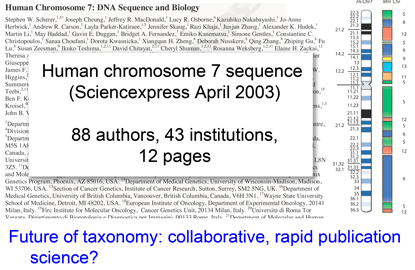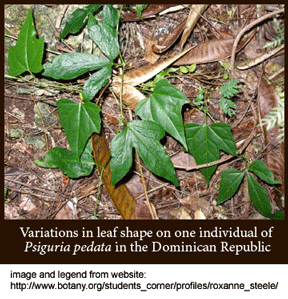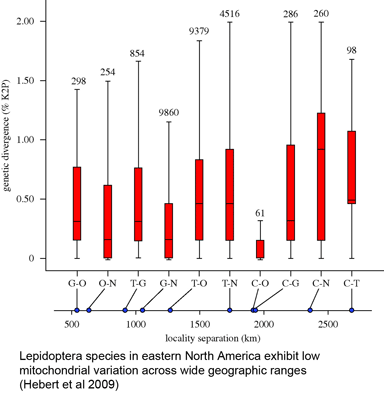PHE researcher Mark Stoeckle is co-author on Jan 2009 J Ornithol paper comparing Scandinavian and North American birds, which found divergent lineages in 19 (24%) of trans-Atlantic species, demonstrating DNA barcoding helps discover diversity even in intensively-studied groups such as birds.
News
Names
In Systema Natura 250 (Andrew Polaszek, ed; CRC Press), a new collection of essays on the state of taxonomy, David Schindel and Scott Miller address how to speed up “naming” of specimens without causing chaos, in chapter entitled “Provisional nomenclature: The on-ramp to taxonomic names.” The authors observe the increasing numbers of undescribed and undescribable specimens (eg fragments, mixed environmental samples) and propose to standardize provisional names (preferred designation of these standardized  temporary placeholders is “taxon label”). As they note, there are many provisional names in GenBank (e.g. Ocyptamus sp. MZH S143_2004), so this is not a change in usual practice, except that the format of provisional names is standardized. As a starting point, Schindel and Miller propose a scheme developed by Council of the Heads of Australian Herbariums (CHAH) and recommend review by Biodiversity Information Standards (TDWG). The CHAH format is:
temporary placeholders is “taxon label”). As they note, there are many provisional names in GenBank (e.g. Ocyptamus sp. MZH S143_2004), so this is not a change in usual practice, except that the format of provisional names is standardized. As a starting point, Schindel and Miller propose a scheme developed by Council of the Heads of Australian Herbariums (CHAH) and recommend review by Biodiversity Information Standards (TDWG). The CHAH format is:
Genus_name sp. Locality (Voucher identifier) Source, where “(Voucher-specimen identifier) is a two-part field consisting of a collector’s name and the voucher specimen number attached to the exemplar of the taxon concept,” and “Source refers to the name of the concept’s proposer.” Regarding sequence data as identifiers, such labels could be generated by a clustering algorithm for DNA barcodes for example. Schindel and Miller discuss short and long-term advantages to taxonomic workflow, academic credit, and scientific sharing.
A standardized format for provisional names is a simple, powerful proposal with many downstream benefits. I hope TDWG will adopt!
DNAHouse
On January 15, WNYC’s Mike Pesca interviewed Jesse and Trinity students Brenda Tan and Matt Cost about their DNAHouse. Their lively, live interview can be downloaded as a podcast from the WNYC website.
Deciphering tropical vines with DNA
 In Dec 2009 Am J Botany researchers from University of Texas apply DNA to sort out species limits of tropical vines in genus Psiguria, part of cucurbit family (Cucurbitaceae) that includes melons, gourds, cucumbers, pumpkins, and squash. Psiguria sp. tax morphological identification due to sometimes drastic changes in leaf and flower structure within and over lifetime of individuals, and frequent absence of male and/or female flowers (approximately 15% of herbarium sheets contain no flowering parts). International Plant Names Index (IPNI) lists 17 species in the genus, although some names are applied to type specimens only. As an aside, IPNI is a model for a dynamic taxonomic names database, containing “names and associated basic bibliographical details of seed plants, ferns and fern allies.” From the website: “[IPNI’s]… goal is to eliminate the need for repeated reference to primary sources for basic bibliographic information about plant names. The data are freely available and are gradually being standardized and checked. IPNI will be a dynamic resource, depending on direct contributions by all members of the botanical community. IPNI is the product of a collaboration between The Royal Botanic Gardens, Kew, The Harvard University Herbaria, and the Australian National Herbarium.”
In Dec 2009 Am J Botany researchers from University of Texas apply DNA to sort out species limits of tropical vines in genus Psiguria, part of cucurbit family (Cucurbitaceae) that includes melons, gourds, cucumbers, pumpkins, and squash. Psiguria sp. tax morphological identification due to sometimes drastic changes in leaf and flower structure within and over lifetime of individuals, and frequent absence of male and/or female flowers (approximately 15% of herbarium sheets contain no flowering parts). International Plant Names Index (IPNI) lists 17 species in the genus, although some names are applied to type specimens only. As an aside, IPNI is a model for a dynamic taxonomic names database, containing “names and associated basic bibliographical details of seed plants, ferns and fern allies.” From the website: “[IPNI’s]… goal is to eliminate the need for repeated reference to primary sources for basic bibliographic information about plant names. The data are freely available and are gradually being standardized and checked. IPNI will be a dynamic resource, depending on direct contributions by all members of the botanical community. IPNI is the product of a collaboration between The Royal Botanic Gardens, Kew, The Harvard University Herbaria, and the Australian National Herbarium.”
Steele and colleagues analyzed 70 Psiguria specimens representing 6 named species, and 14 from closely-related genera, obtained from 9 herbaria in US, Bolivia, and Germany. The target regions were 8 chloroplast intergenic spacers, plus nuclear ITS1, ITS2, and a serine/threonine phophatase intron that prior work suggested might be helpful, for a total length of about 7.7 kb chloroplast and 2 kb nuclear DNA. The authors surmise that the standard barcodes for land plants, namely coding regions of chloroplast genes rbcL and matK, are unlikely to be effective in discriminating Psiguria sp. vines. This may well be true but I hope they will determine rbcL and matK for their well-documented specimens, as this is essential first-pass information for a standardized identification system. Most non-specialists testing an unknown root or leaf will not know if it is a Psiguria sp or even a member of cucurbit family.
On the basis of combined morphologic and molecular data, the researchers conclude the six Psigura species are valid, with caveat that “the molecular results may suggest more than six species” and so “future collections of Psiguria and additional sequencing of molecular markers may contribute to the discovery of additional species.” Finally, Steele and colleagues characterize what they call DNA barcodes, in this case diagnostic nucleotides that uniquely identify the 6 species (1-5 diagnostic nucleotides per species, distributed across 5 chloroplast intergenic spacers). Identification of species-level diagnostic nucleotide characters, together with the relevant primer and amplification protocols, as done here, is a welcome addition to the more usual phylogenetic analysis. However, as mentioned above, for this information to fit into a standardized approach, sequences for the defined markers rbcL and matK are also needed, because that is what will be tested first, except in the minority of situations where the operator already knows the unknown is one of the six Psiguria species.
Rethinking the Inedible
The Martha’s Vineyard Gazette publishes Jesse’s brief essay Rethinking the Inedible about seafood and the Census of Marine Life
High school students explore urban environment with DNA
What sorts of DNA can be found in an urban environment? Last year I helped supervise Trinity High School students Brenda Tan and Matt Cost in an investigation of New York City apartments, sidewalks, and supermarkets with DNA barcoding. Brenda and Matt spent 4 months collecting and documenting everyday items that might contain DNA, and delivered specimens to Center for Conservation Genetics, American Museum of Natural History for testing; 151 (70%) of 217 items yielded DNA barcodes, including a feather duster (ostrich), a hot dog from a street vendor (cow), a dog biscuit (American bison), and a fly in a shipment of grapefruit from Texas (Oriental latrine fly Chrysomya megacephala, an invasive species in southern U.S.). Among other surprising results, the student investigators found 95 different animal species, 16% of human and pet food items mislabeled, and a genetically distinct mystery cockroach that might be a new subspecies or species. I encourage you to peruse the Rockefeller University DNAHouse site which includes their narrative and Q+A reports, spreadsheets detailing specimens and results, and high-resolution images, including of cockroach!

Following example of 2008 student-led “Sushigate.” Brenda and Matt’s DNAHouse study is capturing wide public interest, including stories in New York Times, New York Post, NPR, NBC TV, and over 230 media sites in 9 languages and 30 countries so far. If high school students can make original discoveries with important regulatory and scientific implications using DNA barcoding, then wide application to food products, products from protected and regulated species, detection of invasive species, and biodiversity surveys, including by interested public, is not far off. The most important for general public is food, and I expect to see growing attention on the part of regulatory agencies, distributers, retailers, and consumers to identifying mislabeled food products using DNA barcodes.
1/1000 animal diversity mapped
 In 16 December 2009 Biol Lett, researchers from University of Guelph, University of British Columbia, and Agriculture and Agri-Food Canada report on COI barcodes for 11,289 individuals representing 1,327 species of Lepidoptera (moths and butterflies) collected in eastern North America. This large collection revealed the same patterns of highly restricted intraspecific variation, uncommon barcode sharing, and overlooked diversity seen in numerous smaller studies: average variation within species was 0.43%, while average among congeneric species was 7.7%, 18-fold higher. Only nine cases (0.7%) of barcode sharing between species were observed, and at the same time, large divergences (>2%) suggesting overlooked taxa were found in 67 (5.1%) of cases (in some cases morphological and ecological differences supporting species status were observed). The survey included multiple individuals per species collected at sites 500 to 2800 km apart, with “no significant increase in genetic distances with geographical separation.” Hebert, deWaard, and Landry conclude “an effective identification system can be constructed for the Lepidoptera fauna of eastern North American without extensive geographical surveys of each species,” and that, given likely similar patterns in most terrestrial and marine fauna, “a comprehensive barcode library for animal life can be assembled rapidly,” with diverse benefits to society and science.
In 16 December 2009 Biol Lett, researchers from University of Guelph, University of British Columbia, and Agriculture and Agri-Food Canada report on COI barcodes for 11,289 individuals representing 1,327 species of Lepidoptera (moths and butterflies) collected in eastern North America. This large collection revealed the same patterns of highly restricted intraspecific variation, uncommon barcode sharing, and overlooked diversity seen in numerous smaller studies: average variation within species was 0.43%, while average among congeneric species was 7.7%, 18-fold higher. Only nine cases (0.7%) of barcode sharing between species were observed, and at the same time, large divergences (>2%) suggesting overlooked taxa were found in 67 (5.1%) of cases (in some cases morphological and ecological differences supporting species status were observed). The survey included multiple individuals per species collected at sites 500 to 2800 km apart, with “no significant increase in genetic distances with geographical separation.” Hebert, deWaard, and Landry conclude “an effective identification system can be constructed for the Lepidoptera fauna of eastern North American without extensive geographical surveys of each species,” and that, given likely similar patterns in most terrestrial and marine fauna, “a comprehensive barcode library for animal life can be assembled rapidly,” with diverse benefits to society and science.
In my view, this study should lay to rest the early and persisting worries of some taxonomists that single gene DNA barcoding would distinguish species only in limited situations. For example, in a 2004 PLoS Biol commentary, Moritz and Cicero cautioned “But to determine when and where [DNA barcoding]…is applicable, we now need to discover the boundary conditions.” The 2009 answer is that there are no major restrictions to wide application of DNA barcoding in animals, taxonomically or geographically, and the one regularly encountered limitation is very young species, which represent a small fraction of recognized taxa even in intensively studied groups. At the same time DNA barcoding speeds taxonomic assessment by flagging genetically distinct forms, many of which are found represent unrecognized species, including species that would likely otherwise remain hidden indefinitely. Together with prior work this study refutes a widely-cited (pre-barcoding) estimate that 23% of animal taxa have shared or overlapping mitochondrial DNA sequences (Funk and Omland Ann Rev Genet 2003); this estimate presumably reflected biases in then-existing databases. In closing, I note that Hebert, deWaard, and Landry offer a new yardstick, namely the fraction of the animal kingdom mapped, lifting our eyes up to the goal of a rapid identification system for all eukaryotic life.
DNA House website
Over the past year PHE researcher Mark Stoeckle supervised Trinity High School students Brenda Tan and Matt Cost in an investigation of NYC homes, sidewalks, and markets with DNA barcoding.Their work is summarized in a press release and is presented in more detail on the DNAHouse website, including a narrative report, Q+A, high-resolution images, and specimen and species ID results. Among other surprising results, the student investigators found 95 different animal species, 16% of human and pet food items mislabeled, and a genetically distinct mystery cockroach that might be a new subspecies or species.
Deep Carbon Observatory
The new international Deep Carbon Observatory https://dco.ciw.edu/ led by Robert Hazen and Russ Hemley has launched its website. Â Jesse and Veselin Kostov have helped initiate the DCO and look forward to many discoveries. Enjoy Bob Hazen’s excellent radio interview on Science Friday.
WilsonBook Energy Speech
Venerable (1898) publisher H W Wilson periodically compiles major American speeches. Representative Speeches 2008-2009 edited by Brian Boucher balances the Inaugural Address and two other speeches by Barack Obama with a figure-free version of Jesse’s January 2009 talk about energy and environment, Natural Gas and the Jack Rabbit.